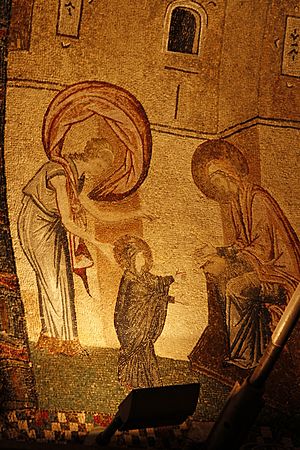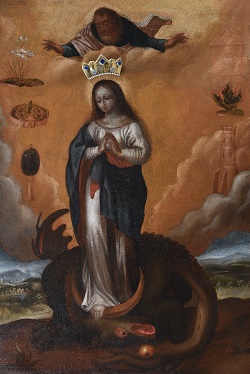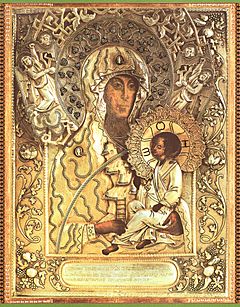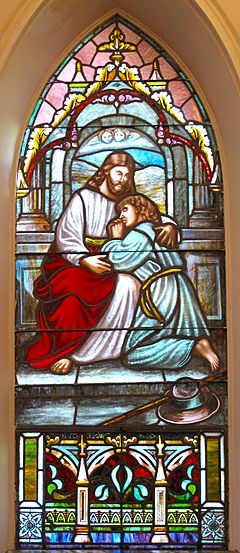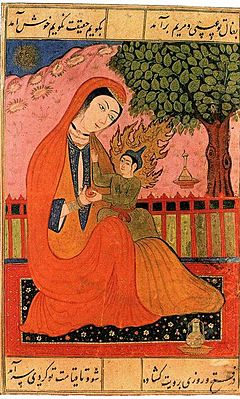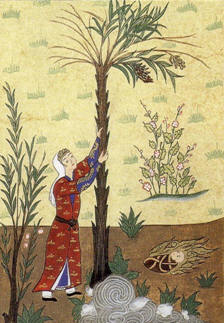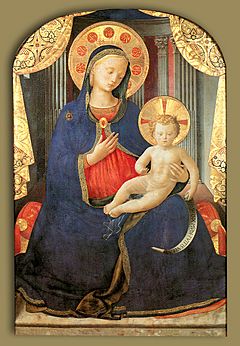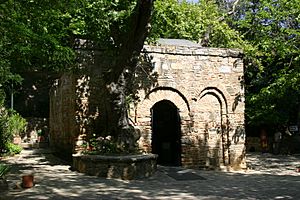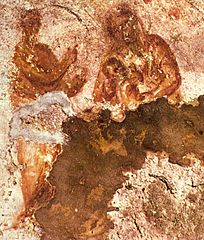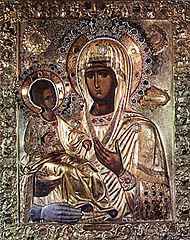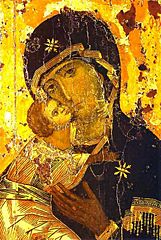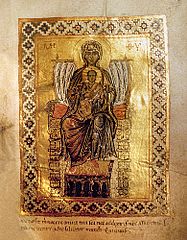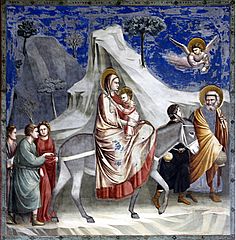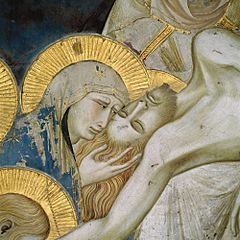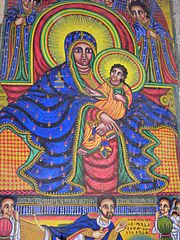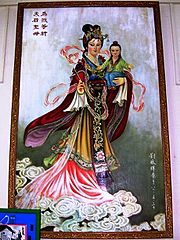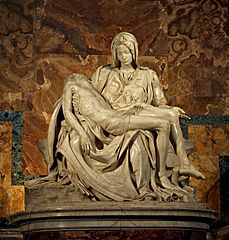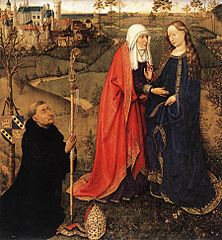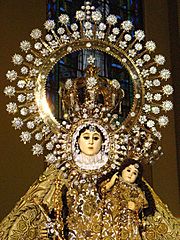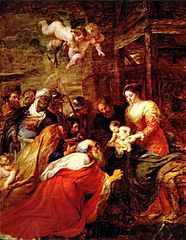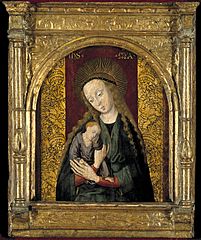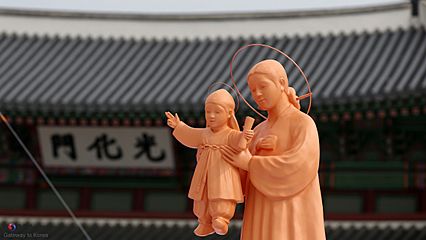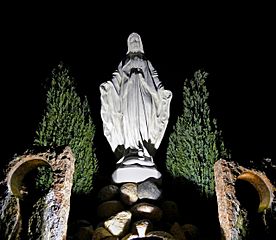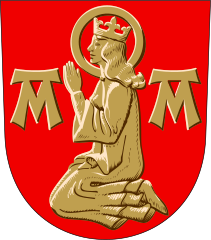Mary, mother of Jesus facts for kids
Quick facts for kids
Mary
|
|
|---|---|

The Madonna del Rosario (c. 6th century), perhaps the oldest icon of Mary in Rome
|
|
| Born | c. 18 BC or September 8 (21), 16 BC Herodian Kingdom of Judea, Roman Empire
|
| Died | 48 AD or August 15 (28), 57 AD (aged 72) |
| Spouse(s) | Joseph |
| Children | Jesus |
| Parent(s) | according to some apocryphal writings Joachim and Anne |
Mary was a Jewish woman from Nazareth who lived in the first century. She was the wife of Joseph and the mother of Jesus. Mary is a very important person in Christianity. People honor her with many different names, like "virgin" or "queen."
Many Christian churches, including the Eastern and Oriental Orthodox, Church of the East, Catholic, Anglican, and Lutheran churches, believe that Mary is the Mother of God because she is Jesus' mother. Other Protestant groups have different ideas, with some seeing her role as less important.
The New Testament says that Mary was a young virgin chosen by God to become pregnant with Jesus through the Holy Spirit. After Jesus was born in Bethlehem, she raised him in Nazareth in Galilee. She was in Jerusalem when Jesus was crucified and stayed with the apostles after he went up to heaven. The Bible does not say much about her later life. However, Catholic and Eastern Christian traditions believe that her body was taken into heaven at the end of her life. This event is called the Assumption of Mary in Western Christianity and the Dormition of the Mother of God in Eastern Christianity.
Mary has been honored since the early days of Christianity. Millions of people consider her to be the holiest and greatest saint. Different Christian groups have various ways of honoring Mary and different beliefs about her. The Catholic Church has special beliefs about Mary, such as her Immaculate Conception (being born without sin) and her Assumption into heaven. Many Protestants believe Mary's role is smaller, arguing that the Bible mainly supports her as the Mother of God and the virgin mother. Mary is also mentioned many times in the Quran, including in a chapter named after her. She holds the highest position among all women in Islam.
People show their devotion to Mary in many ways. This includes various prayers and songs. They also celebrate several Marian feast days and honor relics and images of her. Many churches are built in her honor, and people go on pilgrimages to places dedicated to Mary. Over the centuries, believers have reported many appearances of Mary and miracles that happened through her prayers to God. Mary has also been a popular subject in art, especially in Byzantine art, medieval art, and Renaissance art.
Contents
What Are Mary's Names and Titles?
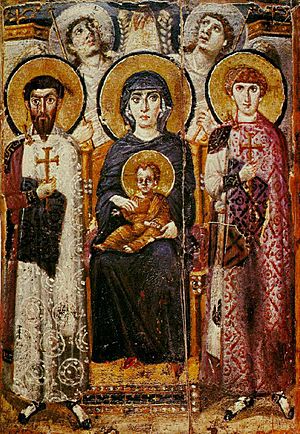
Mary's name in the original New Testament writings came from her Aramaic name, which was Maryam or Mariam. The English name Mary comes from the Greek word Maria. Both Maria and Mariam appear in the New Testament.
Mary's Names in Christianity
In Christianity, Mary is often called the Virgin Mary. This is because Christians believe the Holy Spirit made her pregnant, so she miraculously conceived her first son, Jesus.
She has many other names and titles, such as the Blessed Virgin Mary. This is sometimes shortened to "BVM" or "BMV" from the Latin "Beata Maria Virgo." She is also called Saint Mary, the Mother of God (mostly in Western Christianity), and Theotokos (mostly in Eastern Christianity). Other names include Our Lady and Queen of Heaven. The title "queen of heaven" was used for ancient sky goddesses like Astarte before Christianity.
The titles used for Mary can be different among Anglicans, Lutherans, Catholics, Orthodox, Protestants, Mormons, and other Christians.
The three main titles for Mary used by the Orthodox are Theotokos (meaning "God-bearer"), Aeiparthenos (meaning "Ever-virgin"), and Panagia (meaning "all-holy"). Catholics use many different titles for Mary, and these titles have inspired many artworks.
The title Theotokos was officially recognized at the Council of Ephesus in 431 AD. This means "God-bearer." In Latin, similar titles are Deipara and Dei Genitrix, but it's often translated as Mater Dei ("Mother of God"). The Council said that early Church leaders "did not hesitate to speak of the holy Virgin as the Mother of God."
Some of Mary's titles come directly from the Bible. For example, she is called "Queen Mother" because she is the mother of Jesus, who is sometimes called the "King of Kings." This also comes from the Hebrew tradition of the "Queen-Mother," or Gebirah. Other titles come from reported miracles, special prayers, or times when people called on Mary for help.
Mary's Names in Islam
In Islam, Mary is known as Maryam. She is the mother of Isa (Jesus). Muslims often call her Sayyidatuna, which means "Our Lady." This is similar to Sayyiduna ("Our Lord"), used for prophets. Another loving name for Mary is Siddiqah, meaning "she who confirms the truth" and "she who believes sincerely." She is also called Qānitah, meaning she is always devoted to God and prays a lot. Another title is Tahira, meaning "one who has been purified." This shows her special status as one of only two humans (and the only woman) who was never touched by Satan. In the Quran, she is called "the daughter of Imran" and "the sister of Aaron."
Mary's Life in Ancient Writings
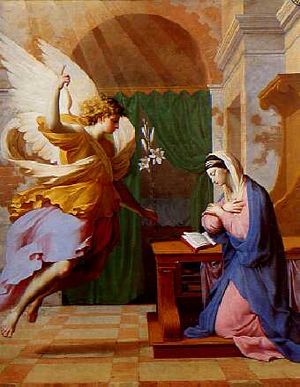
New Testament Accounts
The canonical Gospels (Matthew, Mark, Luke, John) and the Acts of the Apostles are the main historical sources about Mary. These writings are from around the same time Mary lived. They give limited information about Mary because they mainly focus on Jesus' teachings and his apostles.
The earliest mention of Mary in the New Testament is in the epistle to the Galatians, written before the Gospels. She is called "a woman" but not named: "But when the fullness of time had come, God sent his Son, born of a woman, born under the law" (Galatians 4:4).
Mary is mentioned several times in the Gospels and Acts:
- The Gospel of Luke mentions Mary most often, twelve times by name, all in the stories about Jesus' birth and childhood.
- The Gospel of Matthew mentions her by name five times, four in the birth stories and once later.
- The Gospel of Mark names her once and mentions Jesus' mother without naming her in another place.
- The Gospel of John mentions Jesus' mother twice but never names her. She is first seen at the wedding at Cana. The second time, she is near Jesus' cross with other women and the "disciple whom Jesus loved". In John 2:1–12, Jesus talks to Mary, calling her "Woman," which was a respectful way to speak at that time.
- In the Acts of the Apostles, Mary and Jesus' brothers are with the eleven apostles in an upper room after Jesus went to heaven.
In the Book of Revelation, the "woman clothed with the sun" is sometimes thought to be Mary.
Mary's Family Tree
The New Testament doesn't say much about Mary's early life. The Gospel of Matthew gives Jesus' family tree through Joseph, only saying Mary was Joseph's wife. John 19:25 says Mary had a sister, but it's not clear if this sister is Mary of Clopas. Some believe Mary of Clopas was Mary's sister-in-law.
According to Luke, Mary was a relative of Elizabeth, who was married to the priest Zechariah. Elizabeth was from the Tribe of Levi. Some believe Mary, like Joseph, was from the royal Davidic line and the Tribe of Judah.
The Annunciation
Mary lived in "her own house" in Nazareth in Galilee. She was engaged to Joseph, which was the first step of a Jewish marriage. Girls were usually considered ready for marriage around 12 or 13 years old.
The angel Gabriel told Mary that she would be the mother of the promised Messiah. She would become pregnant through the Holy Spirit. After being surprised, she said, "I am the handmaid of the Lord. Let it be done unto me according to your word." Joseph planned to quietly end their engagement, but an angel told him in a dream that Mary's pregnancy was from the Holy Spirit. The angel told him not to be afraid to marry her, which Joseph did.
The angel Gabriel also told Mary that her relative Elizabeth, who had not been able to have children, was now miraculously pregnant. Mary quickly went to see Elizabeth, who lived in "the hill country." When Mary greeted Elizabeth, Elizabeth called Mary "the mother of my Lord." Then Mary spoke words of praise that became known as the Magnificat. After about three months, Mary returned home.
The Birth of Jesus
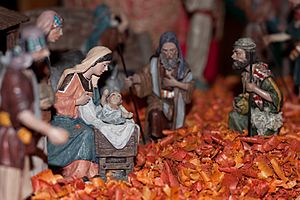
According to the gospel of Luke, the Roman Emperor Augustus ordered everyone to register for a Roman census in their hometown. So, Joseph went to his hometown of Bethlehem with Mary. While they were there, Mary gave birth to Jesus. Because there was no room for them in the inn, she used a manger as a cradle. Mary might have been around 13 or 14 years old when Jesus was born, but no historical record confirms her exact age. After eight days, the boy was named "Jesus," which means "Yahweh is salvation."
After Mary completed her purification time (40 days total), she brought her offerings to the Temple in Jerusalem. They also presented Jesus, as it was written in the law that every firstborn male should be made holy to the Lord. After the prophecies of Simeon and the prophetess Anna, the family "returned into Galilee, to their own city Nazareth."
According to the gospel of Matthew, wise men from the East came to Bethlehem where Jesus and his family were living and worshiped him. Joseph was then warned in a dream that King Herod wanted to kill the baby. The family fled to Egypt and stayed there for some time. After Herod died, they returned to Nazareth in Galilee instead of Bethlehem, because Herod's son Archelaus was ruling Judaea.
Mary is part of the only story from Jesus' teenage years in the New Testament. When Jesus was 12, he got separated from his parents on their way back from the Passover celebration in Jerusalem. They found him in the Temple talking with religious teachers.
Jesus' Ministry
Mary was there when Jesus performed his first miracle at a wedding at Cana, turning water into wine. Later, Mary is present with Jesus' brothers (James, Joseph, Simon, and Judas) and unnamed sisters. Many early Christian writers believed these "brothers" and "sisters" were actually close relatives, like cousins.
Mary is also shown among a group of women at the crucifixion. She stood near the disciple whom Jesus loved along with Mary of Clopas and Mary Magdalene.
After Jesus Went to Heaven
In Acts 1:12-26, Mary is the only person mentioned by name, besides the eleven apostles, who was in the upper room after Jesus went to heaven. Christian tradition believes she was also present with the apostles during Pentecost.
After this, she is not mentioned again in the Bible. However, Catholics believe she is shown as the heavenly woman in the Book of Revelation.
Her death is not recorded in the Bible. But Orthodox tradition, also accepted by Catholics, says she first died a natural death, known as the Dormition of Mary. Then, soon after, her body was taken up into Heaven. The belief that Mary's body was taken into heaven is a dogma (official teaching) of the Catholic Church. It is also believed by the Eastern Orthodox Church, the Oriental Orthodox Church, and some parts of the Anglican Communion.
Later Writings About Mary
According to the apocryphal Gospel of James (a book not in the official Bible), Mary was the daughter of Joachim and Anne. Before Mary was born, Anne could not have children and was very old. Mary was given to serve as a consecrated virgin in the Temple in Jerusalem when she was three years old.
Some unofficial accounts say that Mary was 12–14 years old when she became engaged to Joseph. Her age during her pregnancy varies up to 17 in these writings. Some historians say Mary lived for 11 years after Jesus died, passing away in 41 AD.
The earliest known biography of Mary is Life of the Virgin, written by Maximus the Confessor in the 7th century. It shows her as a key part of the early Christian Church after Jesus' death.
Religious Views of Mary
| Saint Mary |
|
|---|---|
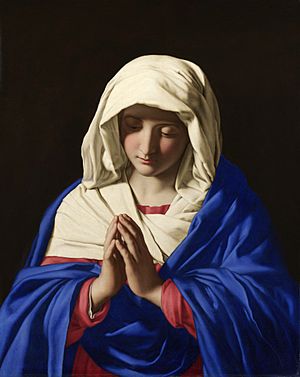
The Virgin in Prayer, by Sassoferrato, c. 1650
|
|
|
|
| Honored in | Christianity, Islam, Druze faith |
| Canonized | Pre-Congregation |
| Major shrine | Santa Maria Maggiore (See Marian shrines) |
| Feast | See Marian feast days |
| Attributes | Blue mantle, crown of 12 stars, pregnant woman, roses, woman with child, woman trampling serpent, crescent moon, woman clothed with the sun, heart pierced by sword, rosary beads |
| Patronage | See Patronage of the Blessed Virgin Mary |
Christian Views
Christian views on Mary are very diverse. While some Christians, like Catholics and Eastern Orthodox, have strong traditions about Mary, many Protestants pay less attention to her. Catholics, Eastern Orthodox, Oriental Orthodox, Anglicans, and Lutherans all honor the Virgin Mary. This honor often involves prayer asking her to pray to her Son, Jesus Christ, for them. It also includes writing poems and songs about Mary, painting icons or carving statues of her, and giving her titles that show her important place among the saints.
Catholic Beliefs
In the Catholic Church, Mary is called "Blessed" because she was taken to Heaven and can pray for those who ask her. This title shows her high status as the greatest among the saints. Catholic teachings clearly state that Mary is not divine. Prayers to her are not answered by her, but by God through her prayers for us. The four main Catholic beliefs about Mary are:
- Her status as Theotokos, or Mother of God.
- Her perpetual virginity (remaining a virgin always).
- The Immaculate Conception (being conceived without original sin).
- Her bodily Assumption into Heaven.
The Blessed Virgin Mary has a very important role in Roman Catholic teachings. Catholics have more beliefs, feasts, prayers, and practices related to Mary than most other Christian groups. The Catechism of the Catholic Church says: "The Church's devotion to the Blessed Virgin is intrinsic to Christian worship."
For centuries, Catholics have made acts of consecration and entrustment to Mary to Mary, her Immaculate Heart of Mary, and her Immaculate Conception. In Catholic teaching, dedicating oneself to Mary does not lessen the love of God. Instead, it makes it stronger, because all dedication is ultimately to God.
After Marian devotions grew in the 16th century, Catholic saints wrote books like Glories of Mary and True Devotion to Mary. These books stressed honoring Mary and taught that "the path to Jesus is through Mary."
Major Marian devotions include: Seven Sorrows of Mary, Rosary and scapular, Miraculous Medal, and Reparations to Mary. The months of May and October are traditionally "Marian months" for Catholics. The daily rosary is encouraged in October, and Marian devotions happen in May. Popes have written many letters to encourage devotion to Mary.
Catholics strongly believe in Mary's roles as protector and intercessor. The Catechism says Mary is "honored with the title 'Mother of God,' to whose protection the faithful fly in all their dangers and needs." Important Marian prayers include: Ave Maria, Alma Redemptoris Mater, Sub tuum praesidium, Ave maris stella, Regina caeli, Ave Regina caelorum, and the Magnificat.
Mary's part in salvation and redemption has also been highlighted in Catholic tradition, but these are not official doctrines. Pope John Paul II's 1987 letter Redemptoris Mater began by saying: "The Mother of the Redeemer has a precise place in the plan of salvation."
In the 20th century, popes John Paul II and Benedict XVI both emphasized Mary's importance in the Catholic Church.
Here are the main Catholic beliefs about Mary:
- Immaculate Conception: Mary was born without original sin.
- Mother of God: Mary, as Jesus' mother, is the Theotokos (God-bearer), or Mother of God.
- Virgin birth of Jesus: Mary became pregnant with Jesus through the Holy Spirit while remaining a virgin.
- Perpetual Virginity: Mary remained a virgin her entire life, even after giving birth to Jesus.
- Dormition: This remembers Mary's "falling asleep" or natural death just before her Assumption. This is part of Eastern Catholic belief, but not a formal Roman Catholic doctrine.
- Assumption: Mary was taken bodily into heaven at or before her death.
This table shows which Christian groups accept these beliefs:
| Belief | Church Action | Accepted by |
|---|---|---|
| Mother of God | First Council of Ephesus, 431 | Catholics, Eastern Orthodox, Oriental Orthodox, Anglicans, Lutherans, some Methodists |
| Virgin birth of Jesus | First Council of Nicaea, 325 | Catholics, Eastern Orthodox, Oriental Orthodox, Assyrians, Anglicans, Baptists, mainline Protestants |
| Assumption of Mary | Munificentissimus Deus encyclical Pope Pius XII, 1950 | Catholics, Eastern and Oriental Orthodox (only following her natural death), some Anglicans, some Lutherans |
| Immaculate Conception | Ineffabilis Deus encyclical Pope Pius IX, 1854 | Catholics, some Anglicans, some Lutherans (early Martin Luther) |
| Perpetual Virginity | Second Ecumenical Council of Constantinople, 553 Smalcald Articles, 1537 | Catholics, Eastern Orthodox, Oriental Orthodox, Assyrians, some Anglicans, some Lutherans (Martin Luther) |
The title "Mother of God" (Theotokos) for Mary was confirmed by the First Council of Ephesus in 431. The Council said Mary is the Mother of God because her son Jesus is one person who is both God and man. This belief is widely accepted by Christians. The term "Mother of God" was used in the oldest known prayer to Mary, Sub tuum praesidium, from around 250 AD.
The Virgin birth of Jesus was a belief held by almost all Christians from the 2nd to the 19th century. It is in the two most common Christian creeds, which say Jesus "was incarnate of the Holy Spirit and the Virgin Mary." The Gospel of Matthew says Mary was a virgin who fulfilled a prophecy. The Gospels of Matthew and Luke say Jesus' conception was not from human parents, and that Mary had "no relations with man" before Jesus' birth. This means Mary conceived Jesus through the power of God the Holy Spirit.
The beliefs of the Assumption or Dormition of Mary are about her death and her body being taken to heaven. The Roman Catholic Church officially defined the doctrine of the Assumption in 1950. Whether Mary died or not is not officially defined, but the document mentions her death. In the Eastern Orthodox Church, the Assumption of the Virgin Mary is believed and celebrated with her Dormition, where they believe she died.
Catholics believe in the Immaculate Conception of Mary, officially declared by Pope Pius IX in 1854. This means she was filled with God's grace from the moment she was conceived and was free from original sin. The Latin Church celebrates a feast on December 8. Orthodox Christians do not accept this belief because their understanding of original sin is different from the Catholic Church's.
The Perpetual Virginity of Mary means Mary remained a virgin even after giving birth to Jesus. The term Ever-Virgin (Greek aeiparthenos) is used, saying Mary stayed a virgin for the rest of her life. This makes Jesus her only biological son, and his conception and birth are seen as miraculous. Orthodox Churches believe Jesus' brothers and sisters were Joseph's children from an earlier marriage. Roman Catholic teaching follows Jerome in believing they were Jesus' cousins.
Eastern Orthodox Beliefs

Eastern Orthodox Christianity has many traditions about the Ever-Virgin Mary, the Theotokos. The Orthodox believe she was and remained a virgin before and after Christ's birth. Theotokia (hymns to the Theotokos) are a very important part of Orthodox church services. They place the Theotokos in the most important position after Christ. In Orthodox tradition, the order of saints starts with the Theotokos, then Angels, Prophets, Apostles, Fathers, and Martyrs. This shows Mary's higher place than the angels. She is also called the "Lady of the Angels."
The ideas of early Church leaders are still important in shaping Orthodox views on Mary. However, Orthodox views on Mary are mostly expressed through hymns, praise, poetry, and honoring icons. One of the most loved Orthodox Akathists (standing hymns) is dedicated to Mary. Five of the twelve Great Feasts in Orthodoxy are dedicated to Mary.
The Orthodox see Mary as "superior to all created beings," but not divine. So, calling her "Saint Mary" is not quite right in their tradition. The Orthodox do not believe Mary was conceived without sin. The Orthodox celebrate the Dormition of the Theotokos, which is about her falling asleep in death, rather than the Assumption.
The Protoevangelium of James, a book outside the official Bible, is the source of many Orthodox beliefs about Mary. It says Mary was dedicated as a virgin at the temple at age three. The high priest Zachariah blessed Mary and told her God had made her name great. While in the temple, an angel miraculously fed Mary until she was 12. Then, an angel told Zachariah to arrange Mary's marriage to a widower in Israel. This story is the theme of many hymns for the Feast of Presentation of Mary, and icons show this story. The Orthodox believe Mary was very important in the growth of Christianity during Jesus' life and after his crucifixion.
Protestant Views
Protestants generally do not honor or pray to saints. They believe Mary is Jesus' mother and "blessed among women" (Luke 1:42), but they usually do not agree that Mary should be honored. She is seen as an excellent example of someone dedicated to God. Because of this, they often do not accept certain church beliefs, like her being free from sin.
Some early Protestants did honor Mary. Martin Luther wrote: "Mary is full of grace, proclaimed to be entirely without sin." However, after 1532, Luther stopped celebrating the feast of the Assumption of Mary and also stopped supporting the Immaculate Conception. John Calvin said, "It cannot be denied that God in choosing and destining Mary to be the Mother of his Son, granted her the highest honor." However, Calvin strongly disagreed that Mary could pray for people between Christ and humans.
While Calvin and Huldrych Zwingli honored Mary in the 16th century, they did so less than Martin Luther. So, the first Protestants did not reject respecting Mary. However, they began to criticize Catholics for honoring Mary too much. After the Council of Trent in the 16th century, as honoring Mary became strongly linked with Catholics, Protestant interest in Mary decreased. During the Age of Enlightenment, almost all interest in Mary disappeared within Protestant churches, although Anglicans and Lutherans continued to honor her.
In the 20th century, some Protestants reacted against the Catholic belief of the Assumption of Mary. The Second Vatican Council helped to bridge some differences between Christians, and Protestants began to show interest in Mary again. In 1997 and 1998, Catholics and Protestants discussed Mary together. However, most Protestants still disagree with honoring Mary and some see it as going against the authority of the Bible.
Anglican Views
The different churches in the Anglican Communion and the Continuing Anglican movement have various views on Mary. This is because there is no single church with complete authority in the Communion. The main church, the Church of England, sees itself as both "Catholic" and "Reformed." So, unlike most Protestant churches, some parts of the Anglican Communion still honor Mary.
Many Anglican Christians recognize Mary's special place in God's plan of salvation as "God-bearer." All Anglican churches confirm in their historic creeds that Jesus was born of the Virgin Mary. They celebrate feast days like the Presentation of Christ in the Temple. This feast is also called the Purification of the Blessed Virgin Mary on February 2. The Annunciation of our Lord to the Blessed Virgin on March 25 was New Year's Day in England for a long time. Anglicans also celebrate the Visitation of the Blessed Virgin on May 31. The feast of St. Mary the Virgin is observed on August 15, the traditional day of the Assumption. The Nativity of the Blessed Virgin is kept on September 8.
The Conception of the Blessed Virgin Mary is celebrated on December 8. In some Anglo-Catholic churches, this feast is called the Immaculate Conception. Most Anglo-Catholics also believe in the Assumption of Mary, but moderate Anglicans see it as a pious (devout) opinion. Protestants within Anglicanism do not celebrate these feasts.
Prayers and ways of honoring Mary vary greatly. For example, since the 19th century, Anglo-Catholics often pray the Rosary, the Angelus, Regina caeli, and other prayers to Mary, similar to Catholic practices. On the other hand, low church Anglicans rarely pray to the Blessed Virgin, except in certain hymns.
The Anglican Society of Mary was formed in 1931 to encourage devotion to Mary among Anglicans. High church Anglicans have beliefs closer to Roman Catholics and continue to honor Mary. For example, Anglican pilgrimages to Our Lady of Lourdes have happened since 1963, and to Our Lady of Walsingham for hundreds of years.
Historically, Catholics and Anglicans have found common ground on issues about Mary. In 2005, a joint statement called Mary: grace and hope in Christ was created through discussions between Anglican and Roman Catholic theologians. This document is not officially approved by either church but is seen as a start to a shared understanding of Mary.
Lutheran Views
Even though Martin Luther strongly disagreed with Roman Catholics on some issues about Mary and the saints, theologians agree that Luther followed the beliefs about Mary from early church councils. He firmly believed that Mary was a perpetual virgin and the Mother of God. Some say Luther believed in the Immaculate Conception long before it became an official Catholic belief in 1854. Others say Luther changed his mind about the Immaculate Conception later, but still believed Mary was without sin throughout her life. For Luther, early in his life, the Assumption of Mary was a known fact, though he later said the Bible didn't mention it and stopped celebrating its feast. He believed that Mary and the saints live on after death.
Luther honored Mary but criticized Catholics for blurring the line between admiring God's grace in a human and worshiping another person. He thought the Catholic practice of celebrating saints' days and asking Mary and other saints to pray for them was idolatry (worshiping something other than God).
Some Lutheran churches, like the Anglo-Lutheran Catholic Church, continue to honor Mary and the saints in the same way Catholics do. They hold all Marian beliefs as part of their faith.
Methodist Views
Methodists do not have extra teachings about the Virgin Mary beyond what is in the Bible and the ecumenical Creeds. Methodists generally accept the belief of the virgin birth but reject the Immaculate Conception. John Wesley, who started the Methodist movement, believed that Mary "continued a pure and unspotted virgin." This means he supported the idea of Mary's perpetual virginity. Modern Methodism believes Mary was a virgin before, during, and right after Jesus' birth. Some Methodists also consider the Assumption of Mary a pious opinion.
Nontrinitarian Views
Nontrinitarians, such as Unitarians, Christadelphians, Jehovah's Witnesses, and Latter Day Saints, also recognize Mary as Jesus Christ's biological mother. However, most reject any immaculate conception and do not use titles like "Mother of God" for Mary. The Latter Day Saint movement believes in the virgin birth of Jesus and Christ's divinity, but they see him as a separate being from God the Father. The Book of Mormon mentions Mary in prophecies, describing her as "most beautiful and fair above all other virgins" and a "precious and chosen vessel."
In nontrinitarian groups that also believe in Christian mortalism (that people sleep after death until resurrection), Mary is not seen as someone who can pray for humans to Jesus, whom they would consider "asleep."
Islamic Views
The Virgin Mary holds a very special place in Islam. The Quran considers her the greatest woman in human history. The Islamic scripture says God promised Mary: "Mary! God has chosen thee, and purified thee; He hath chosen thee above all the women of creation" (3:42).
Muslims often call Mary Sayedetina ("Our Lady"). She is mentioned in the Quran as the daughter of Imran.
Mary is the only woman named in the Quran, and she is mentioned or referred to 50 times. She holds a uniquely honored position among women in the Quran. A sura (chapter) in the Quran is titled "Maryam" (Mary). It is the only sura named after a woman. This chapter tells the story of Mary (Maryam) and Jesus (Isa) from the perspective of Islam.
Mary's Birth in Islam
In a story from Imam Ja'far al-Sadiq, he says that Allah told Imran, "I will give you a blessed boy, who will heal the blind and the leper and raise the dead by My permission. And I will send him as an apostle to the Children of Israel." Imran then told his wife, Hannah, Mary's mother. When Hannah became pregnant, she thought it would be a boy. But when she gave birth to a girl, she said, "Oh my Lord! I have delivered a female, and the male is not like the female, for a girl will not be a prophet." Allah replied in the Quran, "Allah knows better what has been delivered" (3:36). When Allah gave Jesus to Mary, he fulfilled his promise to Imran.
Mary's Motherhood in Islam
Mary was declared (along with Jesus) to be a "Sign of God" to humanity. She "guarded her chastity" and was "obedient." She was "chosen of her mother" and dedicated to Allah even before birth. She was uniquely "Accepted into service by God" among women. Zakariya (Zacharias) cared for her. In her childhood, she lived in the Temple and had special access to Al-Mihrab (believed to be the Holy of Holies). God also provided her with heavenly "provisions."
Mary is also called a "Chosen One," a "Purified One," and a "Truthful one." Her child was conceived through "a Word from God." She is "exalted above all women of The Worlds/Universes."
The Quran tells detailed stories about Maryam (Mary) in two places (3:35 and 19:16). These stories show beliefs in both the Immaculate Conception of Mary and the virgin birth of Jesus. The story in Sura 19 is very similar to the one in the Gospel of Luke. Both begin with an angel visiting Zakariya (Zecharias) and announcing the birth of Yahya (John), followed by the announcement to Mary. It says an angel told Mary she would become Jesus' mother through God's actions alone.
In Islamic tradition, Mary and Jesus were the only children Satan could not touch at birth. God placed a veil between them and Satan. The Quran says Jesus was born of a virgin. The most detailed story of the announcement and birth of Jesus is in Suras 3 and 19 of the Quran.
Bahá'í Faith Views
The Bahá'í Faith honors Mary as Jesus' mother. The Kitáb-i-Íqán, a main Bahá'í religious book, calls Mary "that most beauteous countenance" and "that veiled and immortal Countenance." Bahá'í writings say Jesus Christ was "conceived of the Holy Ghost" and confirm that in the Bahá'í Faith "the reality of the mystery of the Immaculacy of the Virgin Mary is confessed."
Christian Devotions to Mary
History of Devotion
Early Centuries (2nd to 5th)
Justin Martyr was one of the first to compare Eve and Mary. This came from his comparison of Adam and Jesus.
During the second century, the Gospel of James was written. It showed interest in Mary as an important figure and honored her purity. This marked the beginning of devotion to Mary in early Christianity.
Christian devotion to Mary existed before a specific system of honoring her in church services began in the 5th century, after the First Council of Ephesus in 431. In Egypt, people started honoring Mary in the 3rd century. The term Theotokos was used by Origen, an early Church leader. The earliest known prayer to Mary (the Sub tuum praesidium, or Beneath Thy Protection) is from the 3rd century. Its text was found in 1917 on a papyrus in Egypt. After Christianity became legal in 313, images of Mary began to appear in public by the 5th century. Larger churches were also dedicated to Mary, like the Basilica di Santa Maria Maggiore in Rome.
The Council of Ephesus was long thought to have been held in a church in Ephesus dedicated to Mary about a hundred years earlier. However, recent studies show that St. Mary's Church in Ephesus did not exist at the time of the Council, or at least was not dedicated to Mary before 500 AD. The Church of the Seat of Mary in Palestine was built shortly after Marian worship was introduced at the Council of Ephesus, in 456.
Byzantine Era
Ephesus is a center for Mary's worship. It is the site of the first church dedicated to her and is believed to be where she died. Ephesus was previously a center for worshiping Artemis, a virgin goddess. The Temple of Artemis there is one of the Seven Wonders of the Ancient World. The worship of Mary was further promoted by Queen Theodora in the 6th century. Some believe that the worship of Artemis as both virgin and mother in Ephesus contributed to the honor given to Mary.
Middle Ages
The Middle Ages saw many stories about Mary, her parents, and even her grandparents. Mary's popularity grew greatly from the 12th century. This was linked to the Vatican calling Mary the mediatrix (someone who helps bring people together).
After the Reformation
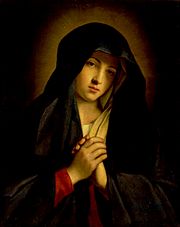
Over the centuries, devotion and honor for Mary have changed a lot among Christian traditions. For example, Protestants pay little attention to Marian prayers. But among all the saints the Orthodox honor, Mary is the most honored. She is considered "more honorable than the Cherubim and more glorious than the Seraphim."
Orthodox theologian Sergei Bulgakov wrote: "Love and veneration of the Blessed Virgin Mary is the soul of Orthodox piety." He also said, "A faith in Christ which does not include his mother is another faith, another Christianity from that of the Orthodox church."
Although Catholics and Orthodox honor Mary, they do not see her as divine, nor do they worship her. Roman Catholics see Mary as below Christ, but uniquely so, as she is above all other creatures. Similarly, Sergei Bulgakov wrote that the Orthodox see Mary as "superior to all created beings" and "ceaselessly pray for her intercession." However, she is not considered a "substitute for the One Mediator" who is Christ. He wrote, "Let Mary be in honor, but let worship be given to the Lord." Catholics do not worship Mary as a divine being, but rather "hyper-venerate" her. In Catholic theology, hyperdulia is for Mary, latria for the worship of God, and dulia for other saints and angels. This three-level system goes back to the Second Council of Nicaea in 787.
Devotions to artistic images of Mary vary among Christian traditions. There is a long tradition of Catholic Marian art, and no image is as common in Catholic art as the image of Madonna and Child. The icon of the Virgin Theotokos with Christ is the most honored icon in the Orthodox Church. Both Roman Catholic and Orthodox Christians honor images and icons of Mary. The Second Council of Nicaea in 787 allowed their veneration, understanding that those who honor the image are honoring the person it represents. The 842 Synod of Constantinople confirmed this. However, in Orthodox practice, believers should pray before and honor only flat, two-dimensional icons, not three-dimensional statues.
The Anglican view towards Mary is generally more accepting than that of most Protestants. Rowan Williams, a former archbishop of Canterbury, wrote in a book about praying with Mary's icons: "It is not only that we cannot understand Mary without seeing her as pointing to Christ; we cannot understand Christ without seeing his attention to Mary."
In 1781, 11 families established a city in the name of King Carlos III. The town was named El Pueblo de Nuestra Señora de los Ángeles de la Porciúncula (Our Lady of the Angels), which is now known as Los Angeles. In 2011, the Queen of Angels Foundation started an annual Grand Marian Procession in Downtown Los Angeles. This procession, held on the last Saturday of August, begins at the Cathedral of Our Lady of the Angels and ends at the church of La Iglesia de Nuestra Señora Reina de los Angeles.
Marian Feast Days
The earliest feasts related to Mary grew out of the feasts celebrating the Nativity of Jesus. According to the Gospel of Luke, 40 days after Jesus' birth, Mary was purified according to Jewish customs, along with the Presentation of Jesus at the Temple. The Feast of the Purification began to be celebrated by the 5th century.
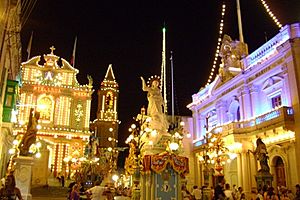
In the 7th and 8th centuries, four more Marian feasts were created in Eastern Christianity. In the West, a feast for Mary just before Christmas was celebrated in Milan and Ravenna, Italy, in the 7th century. The four Roman Marian feasts of Purification, Annunciation, Assumption, and Nativity of Mary were gradually introduced into England by the 11th century.
Over time, the number and types of feasts (and titles) and the ways of honoring Mary have varied greatly among different Christian traditions. Generally, Roman Catholics have many more titles, feasts, and ways of honoring Mary than other Christian traditions. Some feasts are related to specific events, like the Feast of Our Lady of Victory, based on the 1571 victory of the Papal States in the Battle of Lepanto.
Differences in feasts can also come from different beliefs. The Feast of the Assumption is an example. Since not all Christians agree on how Mary died, whether it was a Dormition or Assumption, this feast is celebrated by some denominations and not others. The Catholic Church celebrates the Feast of the Assumption on August 15. Some Eastern Catholics celebrate it as the Dormition of the Theotokos, sometimes on August 28 if they follow the Julian calendar. The Eastern Orthodox also celebrate it as the Dormition of the Theotokos, one of their 12 Great Feasts. Protestants do not celebrate this or other Marian feasts.
Relics of Mary
Before the Reformation, honoring Marian relics was common. Later, honoring Marian images became more popular.
Bodily Relics
Since most Christians believe Mary's body was taken up into heaven, her bodily relics have been limited to things like hair, nails, and breast milk.
According to John Calvin's 1543 Treatise on Relics, her hair was displayed for honor in several churches.
Although honoring Mary's bodily relics is not common today, some traces remain, like the Chapel of the Milk Grotto in Bethlehem, named after Mary's milk.
Mary's Clothes
Clothes believed to have belonged to Mary include the Cincture of the Theotokos kept in the Vatopedi monastery and her Holy Girdle kept in Mount Athos.
Other relics are said to have been collected during later appearances of Mary. For example, her robe, veil, and part of her belt were kept in Blachernae church in Constantinople after she appeared there in the 10th century. These relics, now lost, are celebrated by the Eastern Orthodox and Byzantine Catholic Churches as the Intercession of the Theotokos.
Few other objects are said to have been touched or given by Mary during appearances. One notable example is a 1531 image printed on a tilma, known as Our Lady of Guadalupe, belonging to Juan Diego.
Places Associated with Mary
Places where Mary is believed to have lived include the Basilica della Santa Casa in Loreto, Marche, and the House of the Virgin Mary in Ephesus.
Her burial place is believed by Eastern Christians to be the Tomb of the Virgin Mary in Jerusalem.
The belief that Mary's house was in Ephesus is more recent. It was claimed in the 19th century based on the visions of Anne Catherine Emmerich, a nun in Germany. It has since been called the House of the Virgin Mary by Catholic pilgrims who believe it's where Mary lived until she was taken to heaven. The Gospel of John says Mary went to live with the Disciple whom Jesus loved, who is traditionally believed to be John the Evangelist. Early historians wrote that John later went to Ephesus, which might be why people believed Mary also lived there with John.
The appearance of Our Lady of the Pillar in the first century was believed to be a bilocation (being in two places at once). It happened in Spain while Mary was living in Ephesus or Jerusalem. The pillar she stood on during this appearance is believed to be kept in the Cathedral-Basilica of Our Lady of the Pillar in Zaragoza. It is honored as a relic because it was in physical contact with Mary.
Mary in Art
Iconography (Images)
In paintings, Mary is traditionally shown wearing blue. This tradition started in the Byzantine Empire around 500 AD, where blue was "the color of an empress." A more practical reason for this color is that in Medieval and Renaissance Europe, blue pigment came from lapis lazuli, a stone more valuable than gold. This stone was imported from Afghanistan. Artists' patrons were expected to buy any gold or lapis lazuli for the painting. So, dressing the Virgin in blue showed great devotion and honor. Changes in how Mary was shown in art from the 13th to 15th centuries reflect her changing importance in the Church and society.
Traditional images of Mary include the crucifixion scene, called Stabat Mater. Although not in the Gospels, Mary holding the dead body of her son is a common art theme, called a "pietà" or "pity."
-
Mary nursing the Infant Jesus. Early image from the Catacomb of Priscilla, Rome, c. 2nd century
-
Our Lady of Vladimir, a Byzantine representation of the Theotokos
-
Flight into Egypt by Giotto c. 1304
-
Lamentation by Pietro Lorenzetti, Assisi Basilica, c. 1310–1329
-
Chinese Madonna, St. Francis' Church, Macao
-
Michelangelo's Pietà (1498–99) in St. Peter's Basilica, Vatican City
-
Visitation, from the St Vaast Altarpiece by Jacques Daret, 1434–1435
-
Virgin of Guadalupe, from the Basilica of Our Lady of Guadalupe, Mexico City, 16th century
-
Our Lady of La Naval de Manila statue in Quezon City, Philippines, c. 1593
-
Madonna on Floral Wreath by Peter Paul Rubens with Jan Brueghel the Elder, c. 1619
-
Adoration of the Magi, Rubens, 1634
-
Virgin of Montserrat from Puerto Rico, c. 1775-1825
-
Mary and Jesus, outside the Jongno Catholic Church in Seoul, South Korea.
-
Statue of Mary and Jesus at Gwanghwamun, pictured at the time of Pope Francis' visit to South Korea, 2014.
-
Mary outside St. Nikolai Catholic Church in Ystad 2021
Images for kids
-
Virgin and Child with angels and Sts. George and Theodore. Icon, c. 600, from Saint Catherine's Monastery
-
The Annunciation by Eustache Le Sueur, an example of 17th century Marian art. The Angel Gabriel announces to Mary her pregnancy with Jesus and offers her white lilies.
-
The adoration of the shepherds, a nativity scene in France.
-
The Virgin in Prayer, by Sassoferrato, c. 1650
-
A mosaic from the Hagia Sophia of Constantinople (modern Istanbul), depicting Mary with Jesus, flanked by John II Komnenos (left) and his wife Irene of Hungary (right), c. 1118 AD
-
15th century icon of the Theotokos ("God-bearer")
-
Our Lady of Sorrows by Giovanni Battista Salvi da Sassoferrato, 17th century
-
Madonna of humility by Fra Angelico, c. 1430. A traditional depiction of Mary wearing blue clothes.
See also
 In Spanish: María (madre de Jesús) para niños
In Spanish: María (madre de Jesús) para niños


